Partnership Advantages & Porter's Five Forces: Little Dessert Shop
VerifiedAdded on 2023/01/04
|7
|1950
|64
Report
AI Summary
This report analyzes the business strategy of a dessert shop partnership, evaluating the advantages and disadvantages of partnerships as a business structure. It applies Porter's Five Forces to identify opportunities for competitive advantage within the hospitality industry, considering factors such as the threat of new entrants, power of suppliers and consumers, existing rivalry, and the threat of substitute products. The report also examines the impact of macro environmental factors, including technological, social, and environmental aspects, on the business's operations, highlighting how these factors can drive improvements and sustainability. The analysis provides insights into strategic decision-making for the dessert shop to enhance its market position and profitability. Desklib offers a wide range of similar solved assignments and study resources for students.

Introduction to
Business
1
Business
1
Paraphrase This Document
Need a fresh take? Get an instant paraphrase of this document with our AI Paraphraser
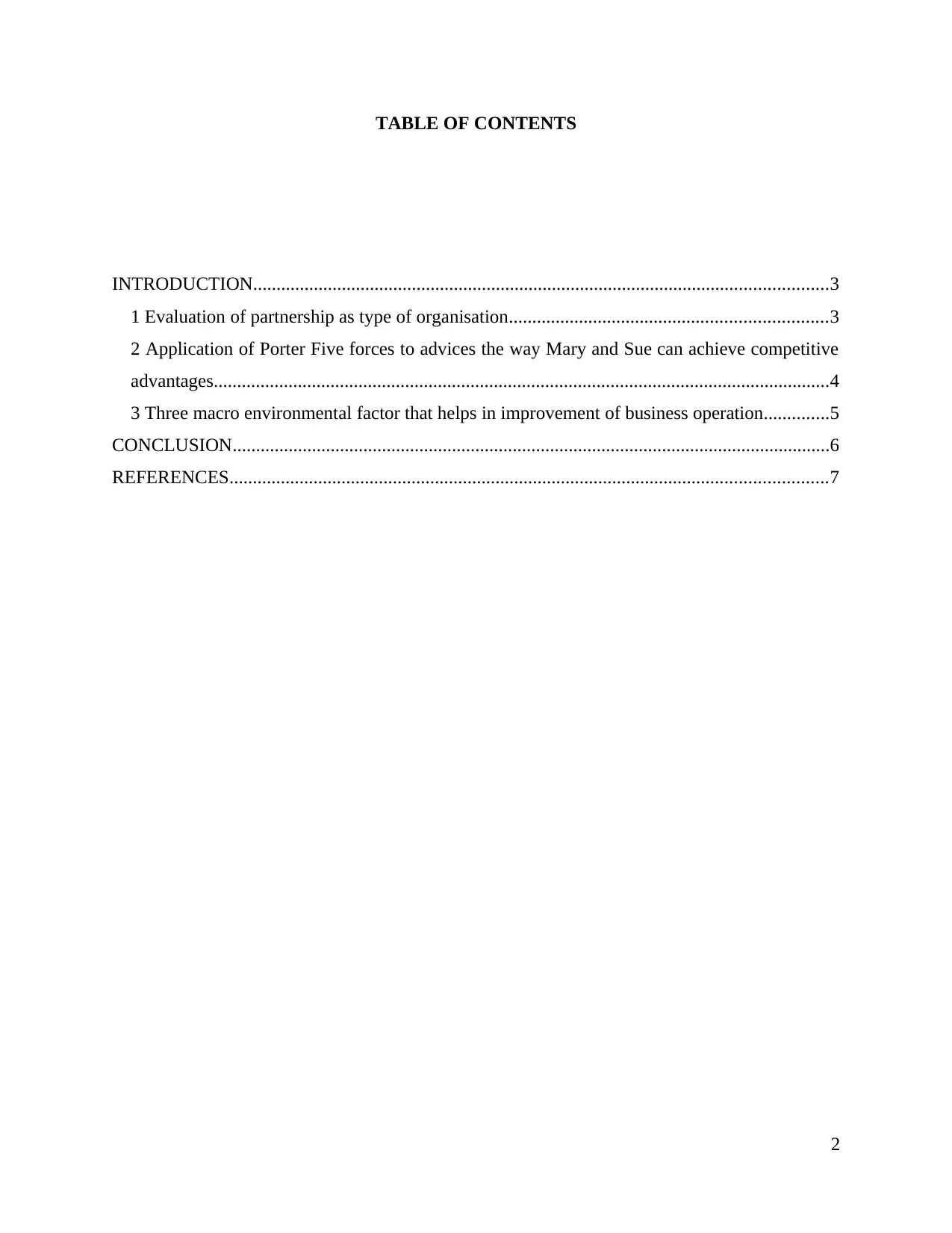
TABLE OF CONTENTS
INTRODUCTION...........................................................................................................................3
1 Evaluation of partnership as type of organisation....................................................................3
2 Application of Porter Five forces to advices the way Mary and Sue can achieve competitive
advantages....................................................................................................................................4
3 Three macro environmental factor that helps in improvement of business operation..............5
CONCLUSION................................................................................................................................6
REFERENCES................................................................................................................................7
2
INTRODUCTION...........................................................................................................................3
1 Evaluation of partnership as type of organisation....................................................................3
2 Application of Porter Five forces to advices the way Mary and Sue can achieve competitive
advantages....................................................................................................................................4
3 Three macro environmental factor that helps in improvement of business operation..............5
CONCLUSION................................................................................................................................6
REFERENCES................................................................................................................................7
2
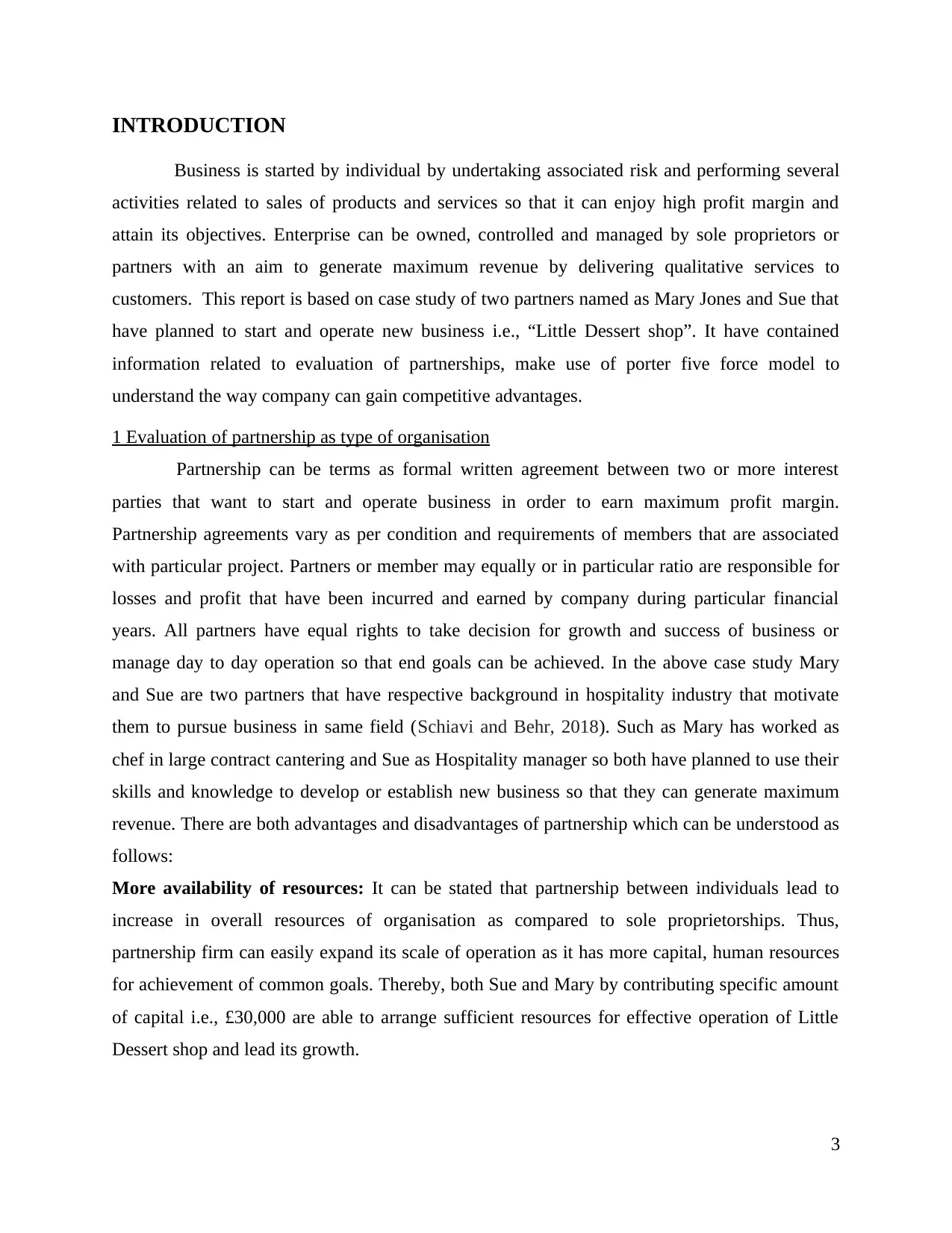
INTRODUCTION
Business is started by individual by undertaking associated risk and performing several
activities related to sales of products and services so that it can enjoy high profit margin and
attain its objectives. Enterprise can be owned, controlled and managed by sole proprietors or
partners with an aim to generate maximum revenue by delivering qualitative services to
customers. This report is based on case study of two partners named as Mary Jones and Sue that
have planned to start and operate new business i.e., “Little Dessert shop”. It have contained
information related to evaluation of partnerships, make use of porter five force model to
understand the way company can gain competitive advantages.
1 Evaluation of partnership as type of organisation
Partnership can be terms as formal written agreement between two or more interest
parties that want to start and operate business in order to earn maximum profit margin.
Partnership agreements vary as per condition and requirements of members that are associated
with particular project. Partners or member may equally or in particular ratio are responsible for
losses and profit that have been incurred and earned by company during particular financial
years. All partners have equal rights to take decision for growth and success of business or
manage day to day operation so that end goals can be achieved. In the above case study Mary
and Sue are two partners that have respective background in hospitality industry that motivate
them to pursue business in same field (Schiavi and Behr, 2018). Such as Mary has worked as
chef in large contract cantering and Sue as Hospitality manager so both have planned to use their
skills and knowledge to develop or establish new business so that they can generate maximum
revenue. There are both advantages and disadvantages of partnership which can be understood as
follows:
More availability of resources: It can be stated that partnership between individuals lead to
increase in overall resources of organisation as compared to sole proprietorships. Thus,
partnership firm can easily expand its scale of operation as it has more capital, human resources
for achievement of common goals. Thereby, both Sue and Mary by contributing specific amount
of capital i.e., £30,000 are able to arrange sufficient resources for effective operation of Little
Dessert shop and lead its growth.
3
Business is started by individual by undertaking associated risk and performing several
activities related to sales of products and services so that it can enjoy high profit margin and
attain its objectives. Enterprise can be owned, controlled and managed by sole proprietors or
partners with an aim to generate maximum revenue by delivering qualitative services to
customers. This report is based on case study of two partners named as Mary Jones and Sue that
have planned to start and operate new business i.e., “Little Dessert shop”. It have contained
information related to evaluation of partnerships, make use of porter five force model to
understand the way company can gain competitive advantages.
1 Evaluation of partnership as type of organisation
Partnership can be terms as formal written agreement between two or more interest
parties that want to start and operate business in order to earn maximum profit margin.
Partnership agreements vary as per condition and requirements of members that are associated
with particular project. Partners or member may equally or in particular ratio are responsible for
losses and profit that have been incurred and earned by company during particular financial
years. All partners have equal rights to take decision for growth and success of business or
manage day to day operation so that end goals can be achieved. In the above case study Mary
and Sue are two partners that have respective background in hospitality industry that motivate
them to pursue business in same field (Schiavi and Behr, 2018). Such as Mary has worked as
chef in large contract cantering and Sue as Hospitality manager so both have planned to use their
skills and knowledge to develop or establish new business so that they can generate maximum
revenue. There are both advantages and disadvantages of partnership which can be understood as
follows:
More availability of resources: It can be stated that partnership between individuals lead to
increase in overall resources of organisation as compared to sole proprietorships. Thus,
partnership firm can easily expand its scale of operation as it has more capital, human resources
for achievement of common goals. Thereby, both Sue and Mary by contributing specific amount
of capital i.e., £30,000 are able to arrange sufficient resources for effective operation of Little
Dessert shop and lead its growth.
3
⊘ This is a preview!⊘
Do you want full access?
Subscribe today to unlock all pages.

Trusted by 1+ million students worldwide
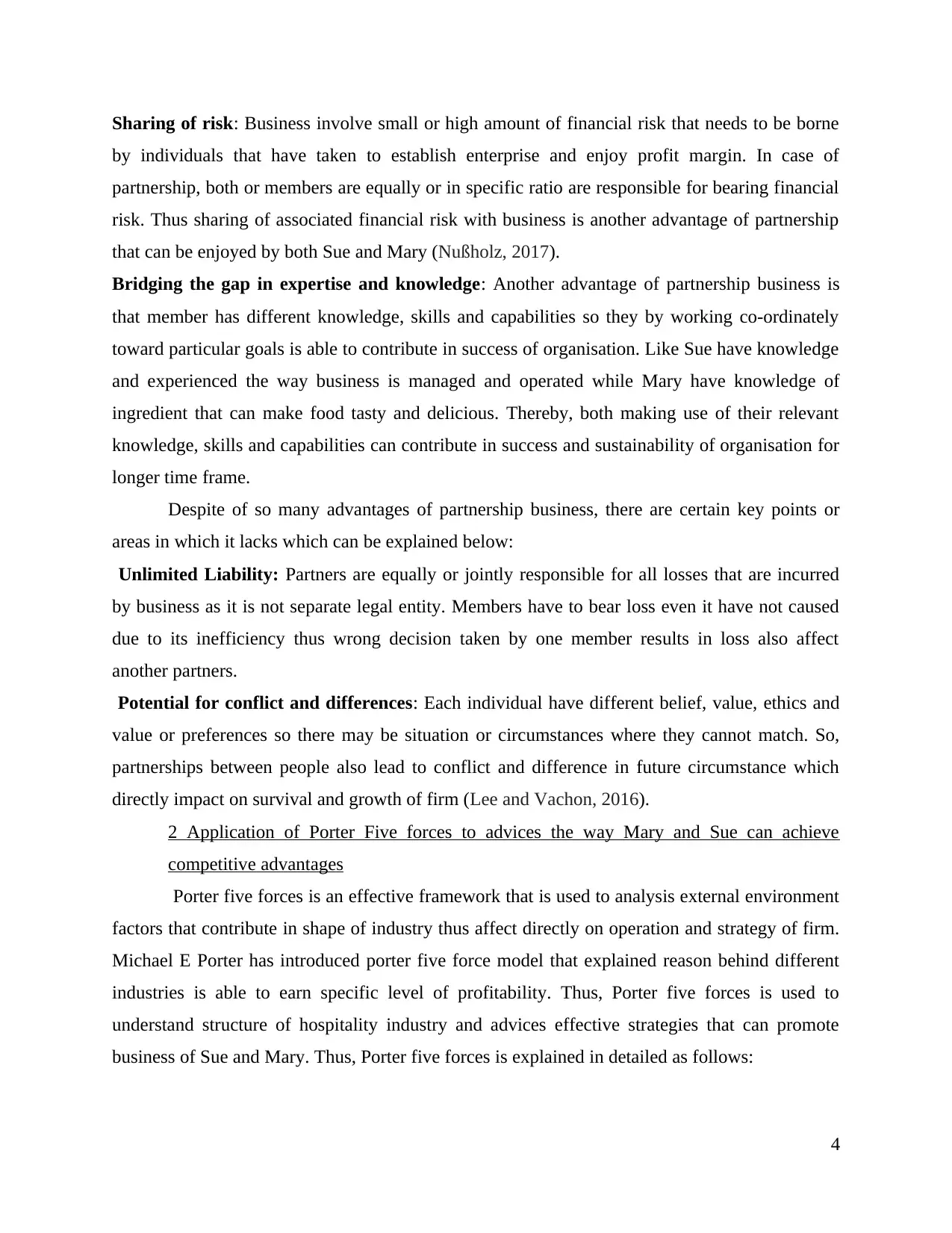
Sharing of risk: Business involve small or high amount of financial risk that needs to be borne
by individuals that have taken to establish enterprise and enjoy profit margin. In case of
partnership, both or members are equally or in specific ratio are responsible for bearing financial
risk. Thus sharing of associated financial risk with business is another advantage of partnership
that can be enjoyed by both Sue and Mary (Nußholz, 2017).
Bridging the gap in expertise and knowledge: Another advantage of partnership business is
that member has different knowledge, skills and capabilities so they by working co-ordinately
toward particular goals is able to contribute in success of organisation. Like Sue have knowledge
and experienced the way business is managed and operated while Mary have knowledge of
ingredient that can make food tasty and delicious. Thereby, both making use of their relevant
knowledge, skills and capabilities can contribute in success and sustainability of organisation for
longer time frame.
Despite of so many advantages of partnership business, there are certain key points or
areas in which it lacks which can be explained below:
Unlimited Liability: Partners are equally or jointly responsible for all losses that are incurred
by business as it is not separate legal entity. Members have to bear loss even it have not caused
due to its inefficiency thus wrong decision taken by one member results in loss also affect
another partners.
Potential for conflict and differences: Each individual have different belief, value, ethics and
value or preferences so there may be situation or circumstances where they cannot match. So,
partnerships between people also lead to conflict and difference in future circumstance which
directly impact on survival and growth of firm (Lee and Vachon, 2016).
2 Application of Porter Five forces to advices the way Mary and Sue can achieve
competitive advantages
Porter five forces is an effective framework that is used to analysis external environment
factors that contribute in shape of industry thus affect directly on operation and strategy of firm.
Michael E Porter has introduced porter five force model that explained reason behind different
industries is able to earn specific level of profitability. Thus, Porter five forces is used to
understand structure of hospitality industry and advices effective strategies that can promote
business of Sue and Mary. Thus, Porter five forces is explained in detailed as follows:
4
by individuals that have taken to establish enterprise and enjoy profit margin. In case of
partnership, both or members are equally or in specific ratio are responsible for bearing financial
risk. Thus sharing of associated financial risk with business is another advantage of partnership
that can be enjoyed by both Sue and Mary (Nußholz, 2017).
Bridging the gap in expertise and knowledge: Another advantage of partnership business is
that member has different knowledge, skills and capabilities so they by working co-ordinately
toward particular goals is able to contribute in success of organisation. Like Sue have knowledge
and experienced the way business is managed and operated while Mary have knowledge of
ingredient that can make food tasty and delicious. Thereby, both making use of their relevant
knowledge, skills and capabilities can contribute in success and sustainability of organisation for
longer time frame.
Despite of so many advantages of partnership business, there are certain key points or
areas in which it lacks which can be explained below:
Unlimited Liability: Partners are equally or jointly responsible for all losses that are incurred
by business as it is not separate legal entity. Members have to bear loss even it have not caused
due to its inefficiency thus wrong decision taken by one member results in loss also affect
another partners.
Potential for conflict and differences: Each individual have different belief, value, ethics and
value or preferences so there may be situation or circumstances where they cannot match. So,
partnerships between people also lead to conflict and difference in future circumstance which
directly impact on survival and growth of firm (Lee and Vachon, 2016).
2 Application of Porter Five forces to advices the way Mary and Sue can achieve
competitive advantages
Porter five forces is an effective framework that is used to analysis external environment
factors that contribute in shape of industry thus affect directly on operation and strategy of firm.
Michael E Porter has introduced porter five force model that explained reason behind different
industries is able to earn specific level of profitability. Thus, Porter five forces is used to
understand structure of hospitality industry and advices effective strategies that can promote
business of Sue and Mary. Thus, Porter five forces is explained in detailed as follows:
4
Paraphrase This Document
Need a fresh take? Get an instant paraphrase of this document with our AI Paraphraser
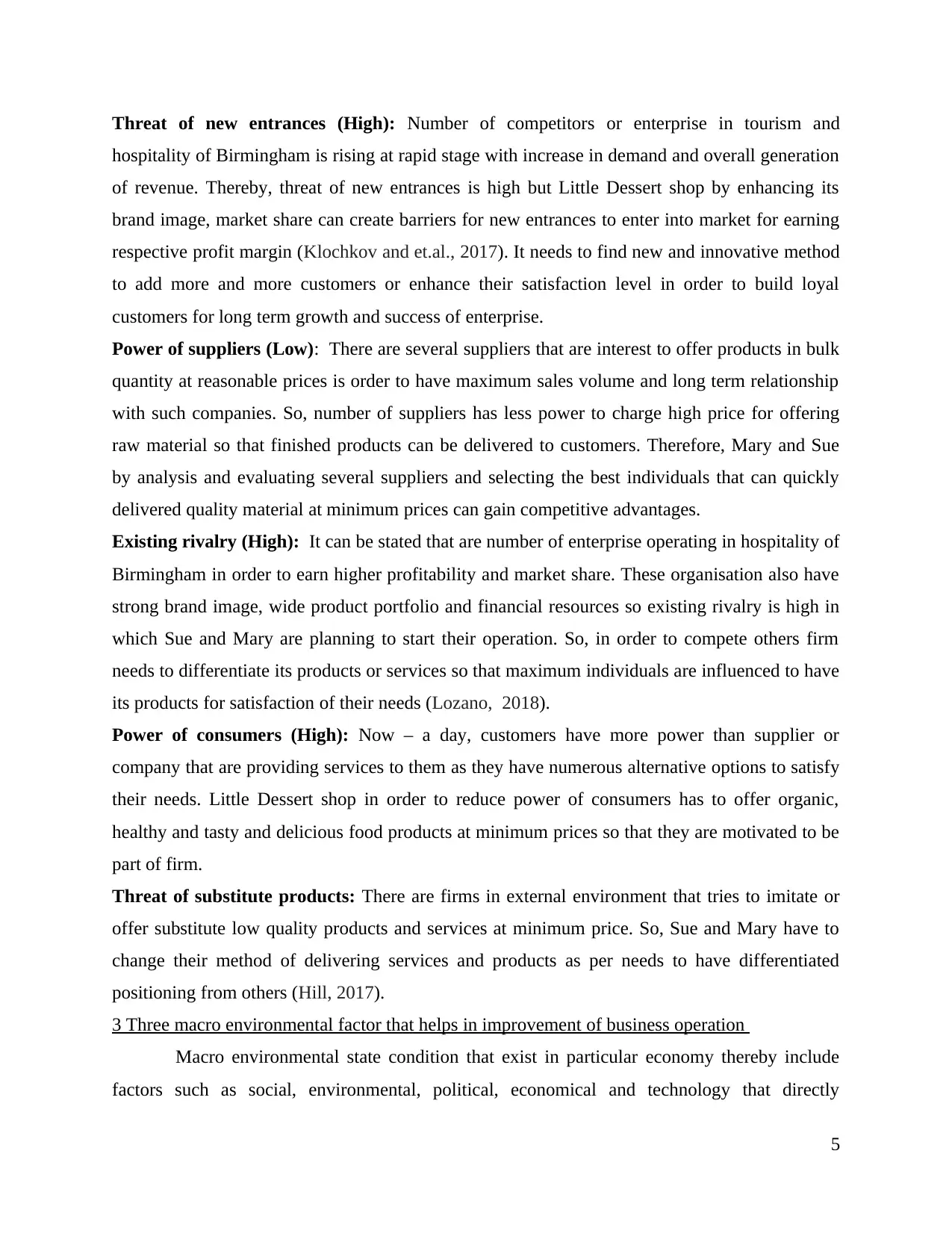
Threat of new entrances (High): Number of competitors or enterprise in tourism and
hospitality of Birmingham is rising at rapid stage with increase in demand and overall generation
of revenue. Thereby, threat of new entrances is high but Little Dessert shop by enhancing its
brand image, market share can create barriers for new entrances to enter into market for earning
respective profit margin (Klochkov and et.al., 2017). It needs to find new and innovative method
to add more and more customers or enhance their satisfaction level in order to build loyal
customers for long term growth and success of enterprise.
Power of suppliers (Low): There are several suppliers that are interest to offer products in bulk
quantity at reasonable prices is order to have maximum sales volume and long term relationship
with such companies. So, number of suppliers has less power to charge high price for offering
raw material so that finished products can be delivered to customers. Therefore, Mary and Sue
by analysis and evaluating several suppliers and selecting the best individuals that can quickly
delivered quality material at minimum prices can gain competitive advantages.
Existing rivalry (High): It can be stated that are number of enterprise operating in hospitality of
Birmingham in order to earn higher profitability and market share. These organisation also have
strong brand image, wide product portfolio and financial resources so existing rivalry is high in
which Sue and Mary are planning to start their operation. So, in order to compete others firm
needs to differentiate its products or services so that maximum individuals are influenced to have
its products for satisfaction of their needs (Lozano, 2018).
Power of consumers (High): Now – a day, customers have more power than supplier or
company that are providing services to them as they have numerous alternative options to satisfy
their needs. Little Dessert shop in order to reduce power of consumers has to offer organic,
healthy and tasty and delicious food products at minimum prices so that they are motivated to be
part of firm.
Threat of substitute products: There are firms in external environment that tries to imitate or
offer substitute low quality products and services at minimum price. So, Sue and Mary have to
change their method of delivering services and products as per needs to have differentiated
positioning from others (Hill, 2017).
3 Three macro environmental factor that helps in improvement of business operation
Macro environmental state condition that exist in particular economy thereby include
factors such as social, environmental, political, economical and technology that directly
5
hospitality of Birmingham is rising at rapid stage with increase in demand and overall generation
of revenue. Thereby, threat of new entrances is high but Little Dessert shop by enhancing its
brand image, market share can create barriers for new entrances to enter into market for earning
respective profit margin (Klochkov and et.al., 2017). It needs to find new and innovative method
to add more and more customers or enhance their satisfaction level in order to build loyal
customers for long term growth and success of enterprise.
Power of suppliers (Low): There are several suppliers that are interest to offer products in bulk
quantity at reasonable prices is order to have maximum sales volume and long term relationship
with such companies. So, number of suppliers has less power to charge high price for offering
raw material so that finished products can be delivered to customers. Therefore, Mary and Sue
by analysis and evaluating several suppliers and selecting the best individuals that can quickly
delivered quality material at minimum prices can gain competitive advantages.
Existing rivalry (High): It can be stated that are number of enterprise operating in hospitality of
Birmingham in order to earn higher profitability and market share. These organisation also have
strong brand image, wide product portfolio and financial resources so existing rivalry is high in
which Sue and Mary are planning to start their operation. So, in order to compete others firm
needs to differentiate its products or services so that maximum individuals are influenced to have
its products for satisfaction of their needs (Lozano, 2018).
Power of consumers (High): Now – a day, customers have more power than supplier or
company that are providing services to them as they have numerous alternative options to satisfy
their needs. Little Dessert shop in order to reduce power of consumers has to offer organic,
healthy and tasty and delicious food products at minimum prices so that they are motivated to be
part of firm.
Threat of substitute products: There are firms in external environment that tries to imitate or
offer substitute low quality products and services at minimum price. So, Sue and Mary have to
change their method of delivering services and products as per needs to have differentiated
positioning from others (Hill, 2017).
3 Three macro environmental factor that helps in improvement of business operation
Macro environmental state condition that exist in particular economy thereby include
factors such as social, environmental, political, economical and technology that directly
5
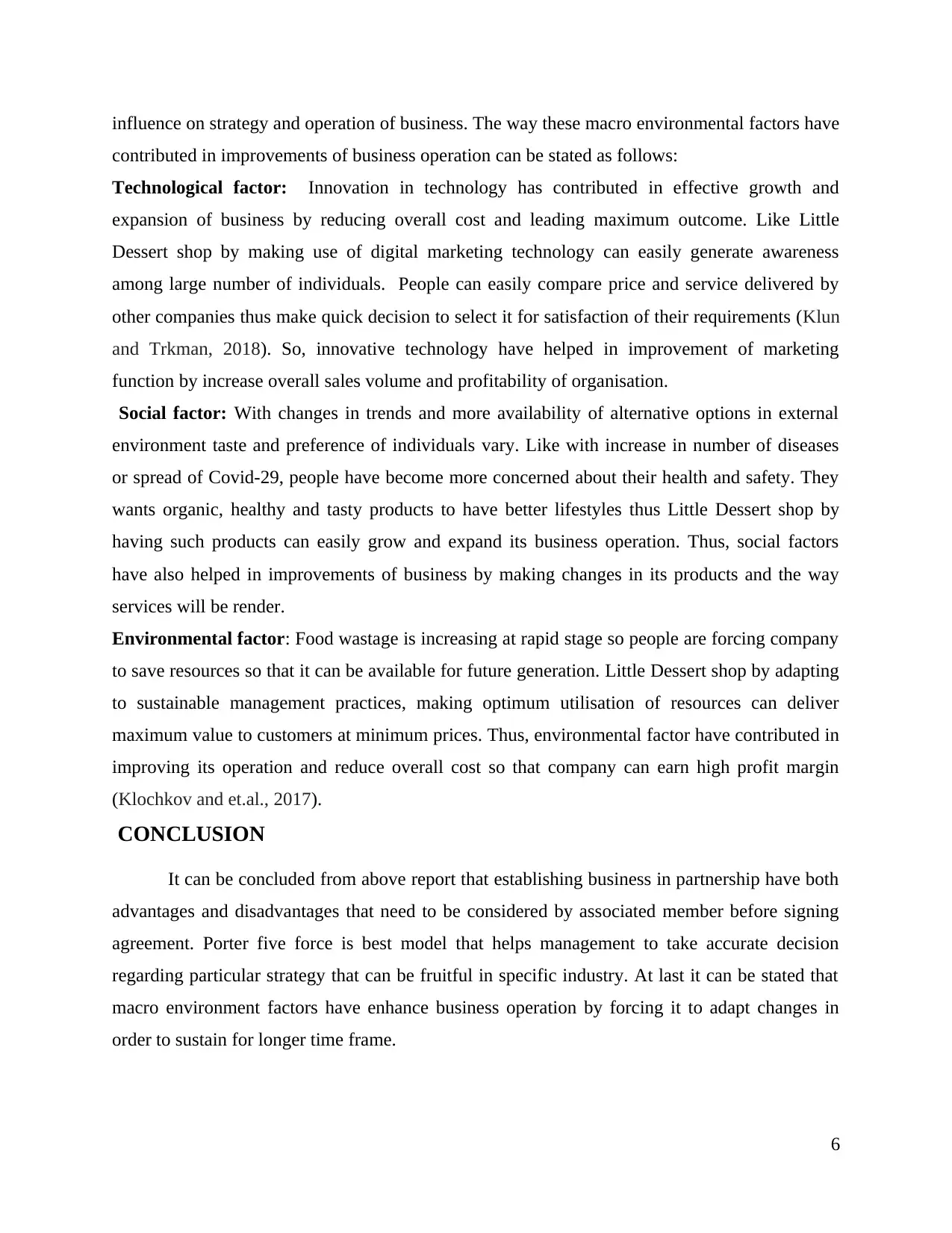
influence on strategy and operation of business. The way these macro environmental factors have
contributed in improvements of business operation can be stated as follows:
Technological factor: Innovation in technology has contributed in effective growth and
expansion of business by reducing overall cost and leading maximum outcome. Like Little
Dessert shop by making use of digital marketing technology can easily generate awareness
among large number of individuals. People can easily compare price and service delivered by
other companies thus make quick decision to select it for satisfaction of their requirements (Klun
and Trkman, 2018). So, innovative technology have helped in improvement of marketing
function by increase overall sales volume and profitability of organisation.
Social factor: With changes in trends and more availability of alternative options in external
environment taste and preference of individuals vary. Like with increase in number of diseases
or spread of Covid-29, people have become more concerned about their health and safety. They
wants organic, healthy and tasty products to have better lifestyles thus Little Dessert shop by
having such products can easily grow and expand its business operation. Thus, social factors
have also helped in improvements of business by making changes in its products and the way
services will be render.
Environmental factor: Food wastage is increasing at rapid stage so people are forcing company
to save resources so that it can be available for future generation. Little Dessert shop by adapting
to sustainable management practices, making optimum utilisation of resources can deliver
maximum value to customers at minimum prices. Thus, environmental factor have contributed in
improving its operation and reduce overall cost so that company can earn high profit margin
(Klochkov and et.al., 2017).
CONCLUSION
It can be concluded from above report that establishing business in partnership have both
advantages and disadvantages that need to be considered by associated member before signing
agreement. Porter five force is best model that helps management to take accurate decision
regarding particular strategy that can be fruitful in specific industry. At last it can be stated that
macro environment factors have enhance business operation by forcing it to adapt changes in
order to sustain for longer time frame.
6
contributed in improvements of business operation can be stated as follows:
Technological factor: Innovation in technology has contributed in effective growth and
expansion of business by reducing overall cost and leading maximum outcome. Like Little
Dessert shop by making use of digital marketing technology can easily generate awareness
among large number of individuals. People can easily compare price and service delivered by
other companies thus make quick decision to select it for satisfaction of their requirements (Klun
and Trkman, 2018). So, innovative technology have helped in improvement of marketing
function by increase overall sales volume and profitability of organisation.
Social factor: With changes in trends and more availability of alternative options in external
environment taste and preference of individuals vary. Like with increase in number of diseases
or spread of Covid-29, people have become more concerned about their health and safety. They
wants organic, healthy and tasty products to have better lifestyles thus Little Dessert shop by
having such products can easily grow and expand its business operation. Thus, social factors
have also helped in improvements of business by making changes in its products and the way
services will be render.
Environmental factor: Food wastage is increasing at rapid stage so people are forcing company
to save resources so that it can be available for future generation. Little Dessert shop by adapting
to sustainable management practices, making optimum utilisation of resources can deliver
maximum value to customers at minimum prices. Thus, environmental factor have contributed in
improving its operation and reduce overall cost so that company can earn high profit margin
(Klochkov and et.al., 2017).
CONCLUSION
It can be concluded from above report that establishing business in partnership have both
advantages and disadvantages that need to be considered by associated member before signing
agreement. Porter five force is best model that helps management to take accurate decision
regarding particular strategy that can be fruitful in specific industry. At last it can be stated that
macro environment factors have enhance business operation by forcing it to adapt changes in
order to sustain for longer time frame.
6
⊘ This is a preview!⊘
Do you want full access?
Subscribe today to unlock all pages.

Trusted by 1+ million students worldwide
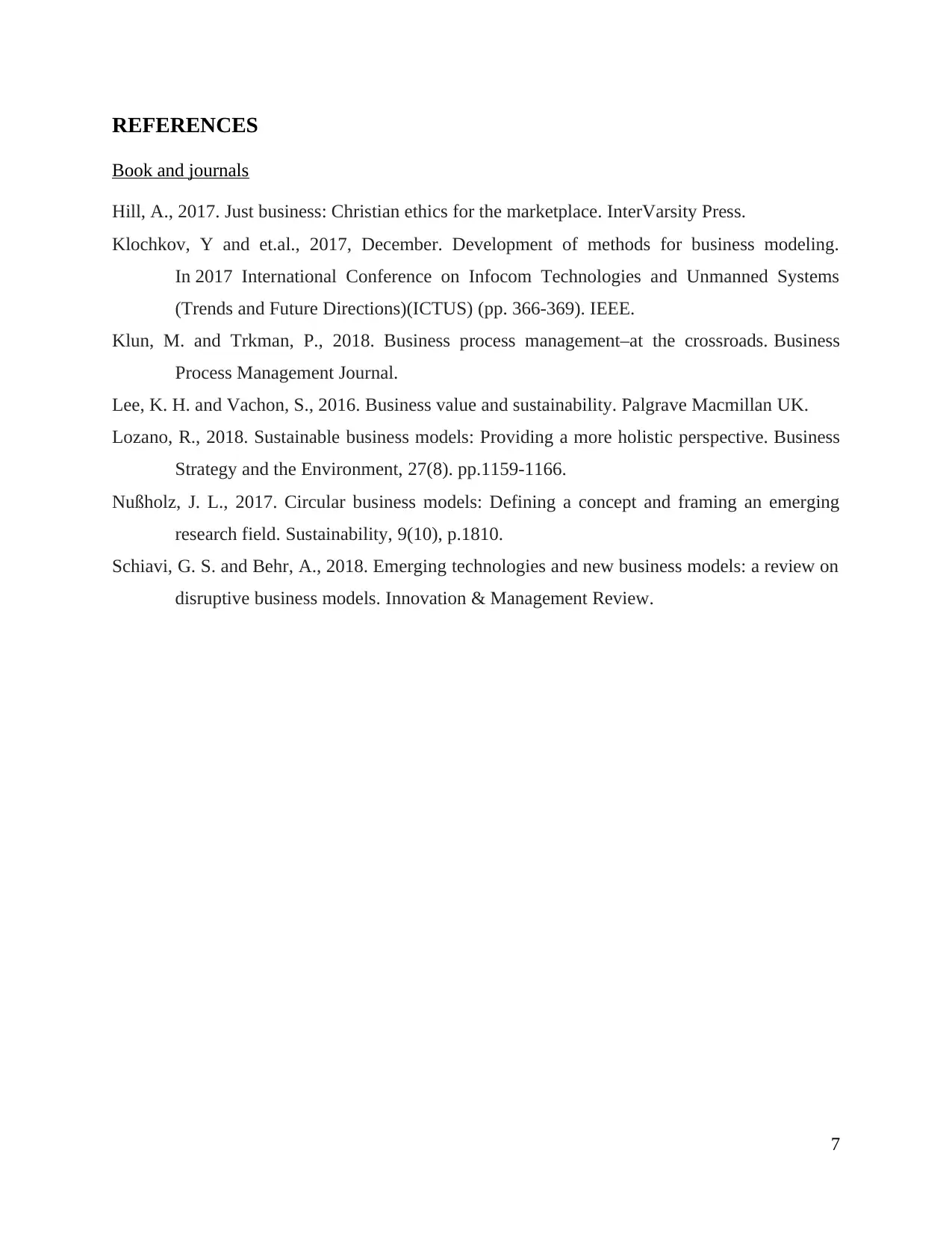
REFERENCES
Book and journals
Hill, A., 2017. Just business: Christian ethics for the marketplace. InterVarsity Press.
Klochkov, Y and et.al., 2017, December. Development of methods for business modeling.
In 2017 International Conference on Infocom Technologies and Unmanned Systems
(Trends and Future Directions)(ICTUS) (pp. 366-369). IEEE.
Klun, M. and Trkman, P., 2018. Business process management–at the crossroads. Business
Process Management Journal.
Lee, K. H. and Vachon, S., 2016. Business value and sustainability. Palgrave Macmillan UK.
Lozano, R., 2018. Sustainable business models: Providing a more holistic perspective. Business
Strategy and the Environment, 27(8). pp.1159-1166.
Nußholz, J. L., 2017. Circular business models: Defining a concept and framing an emerging
research field. Sustainability, 9(10), p.1810.
Schiavi, G. S. and Behr, A., 2018. Emerging technologies and new business models: a review on
disruptive business models. Innovation & Management Review.
7
Book and journals
Hill, A., 2017. Just business: Christian ethics for the marketplace. InterVarsity Press.
Klochkov, Y and et.al., 2017, December. Development of methods for business modeling.
In 2017 International Conference on Infocom Technologies and Unmanned Systems
(Trends and Future Directions)(ICTUS) (pp. 366-369). IEEE.
Klun, M. and Trkman, P., 2018. Business process management–at the crossroads. Business
Process Management Journal.
Lee, K. H. and Vachon, S., 2016. Business value and sustainability. Palgrave Macmillan UK.
Lozano, R., 2018. Sustainable business models: Providing a more holistic perspective. Business
Strategy and the Environment, 27(8). pp.1159-1166.
Nußholz, J. L., 2017. Circular business models: Defining a concept and framing an emerging
research field. Sustainability, 9(10), p.1810.
Schiavi, G. S. and Behr, A., 2018. Emerging technologies and new business models: a review on
disruptive business models. Innovation & Management Review.
7
1 out of 7
Related Documents
Your All-in-One AI-Powered Toolkit for Academic Success.
+13062052269
info@desklib.com
Available 24*7 on WhatsApp / Email
![[object Object]](/_next/static/media/star-bottom.7253800d.svg)
Unlock your academic potential
Copyright © 2020–2025 A2Z Services. All Rights Reserved. Developed and managed by ZUCOL.





